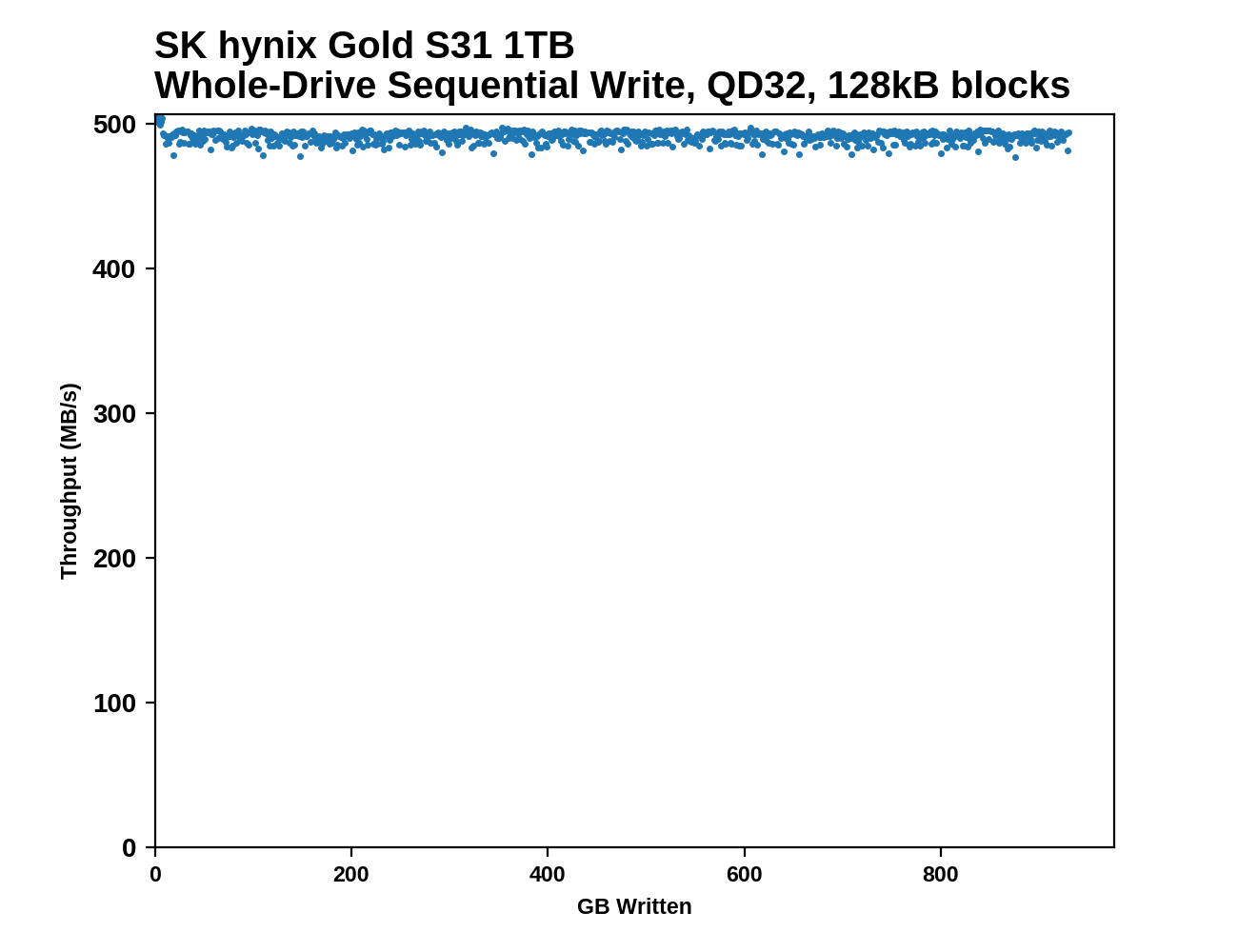The SK Hynix Gold S31 SATA SSD Review: Hynix 3D NAND Finally Shows Up
by Billy Tallis on November 13, 2019 12:00 PM ESTWhole-Drive Fill
This test starts with a freshly-erased drive and fills it with 128kB sequential writes at a queue depth of 32, whilst recording the write speed for each 1GB segment. This test is not representative of any ordinary client/consumer usage pattern, but it does allow us to observe transitions in the drive's behavior as it fills up. This can allow us to estimate the size of any SLC write cache, and get a sense for how much performance remains on the rare occasions where real-world usage keeps writing data after filling the cache.
 |
|||||||||
The SK Hynix Gold S31 drives seem to have relatively small SLC cache sizes: a bit less than 4GB for the 250GB model, and around 8GB for the 500GB and 1TB models. The 1TB model barely loses any speed after the cache fills up, but the smaller two are significantly slower once the cache runs out. The 250GB S31 is also a few percent slower even at the beginning when writing to its SLC cache, but it's still pretty close to saturating the SATA link. All three S31s show very consistent sequential write speeds after the cache is full, with no long-term drift in performance and minimal short-term variation.
 |
|||||||||
| Average Throughput for last 16 GB | Overall Average Throughput | ||||||||
The 1TB S31's post-SLC performance is as good as any other mainstream SATA drive, but the sustained performance from the two smaller models is a bit on the slow side. Most of the competition in this space uses 256Gb TLC dies, but the Hynix drives are all making due with fewer 512Gb modules, consequently having less parallelism to work with. Even so, the smallest S31 is still clearly faster than the DRAMless or QLC-based drives.










22 Comments
View All Comments
MenhirMike - Wednesday, November 13, 2019 - link
We're not going to get under 10c/GB anytime soon, will we? SATA SSDs seem to be stagnant - performance is OK, power consumtion is OK, price is $100 for 1TB, endurance is the usual 0.3 WPD - and yet there are constantly new products with different components and basically the same performance/power/price.Is there a limitation that currently causes stagnation? (I know that SATA is inherently limited in performance, but price shouldn't be stagnant if the main need in that sector is more capacity for less money, with performance/power/endurance being the same)
FunBunny2 - Wednesday, November 13, 2019 - link
"price shouldn't be stagnant if the main need in that sector is more capacity for less money"all of these companies face the Tyranny of Fixed Cost, i.e. the BoM is almost all amortization of the plant and equipment to make the various bits and pieces. sand, some chemicals, and a watchman or two to hover over the machines amount to the variable cost. in such a situation, the only way to lower *average cost* (and shut up the bean counters) is to ship more product and thus spread the fixed cost a tad thinner. lots more product. but that, in turn, is strictly limited by user demand. they're caught between a rock and a hard place. they end up viewing the situation as zero-sum game; one can win only if the other(s) lose when there's little to no global (in every sense of the word) growth. welcome to Earthly Stagnation.
dromoxen - Thursday, November 14, 2019 - link
Having Dr ManHattan looking after your machines is a very expensive business , Rorschach is very unreliable too.eek2121 - Wednesday, November 13, 2019 - link
Except prices have been falling. You just don't realize it because it happens over time.These drives are as cheap as Samsung's QLC drives, without the disadvantages.
Slash3 - Wednesday, November 13, 2019 - link
SSD prices have been basically flat since October/November 2018. Check the price tracking for a 500GB/1TB MX500 or 860 Evo and there have been a few variations but nothing substantial or permanent.I'd love to pick up more large capacity solid state to replace some of my HDDs, but I bought two 2TB SSDs over a year ago and they're actually a few dollars *more* expensive now.
At this point, it may actually be cheaper to build a large NAS using MicroSD cards...
eek2121 - Wednesday, November 13, 2019 - link
I paid the same amount for my 2 TB 970 evo as I did my 1 TB 960 evo 2.5-3 years ago. Also, don't track specific drivers, look at charts. NAND is coming down. It just takes time.Slash3 - Wednesday, November 13, 2019 - link
/s implied with respect to the MicroSD card NAS, if it weren't obvious.Although that would be fun to build.
nandnandnand - Wednesday, November 13, 2019 - link
Sale prices are hitting 8c/GB. Don't pay 10c/GB if you live in America. As the average drive capacity goes up, the prices will continue to go down.Thankfully, 100 GB and larger games are a thing, so that should create some demand.
deil - Thursday, November 14, 2019 - link
we might PLC coming soon, so we might see some 1 TB/1.5 TB/2TB/3TB sata's soon and as they are 20% bigger after amortization wears off, almost 20% cheaper it will become.main focus will go to PCIE4.0 now though. so I would say next December expect 2 or 3 products with same nand. 120GB/240 will not go lower than its is now.
deil - Thursday, November 14, 2019 - link
in there on the article. We already did on 1 TB ones. and PLC will go even lower.ADATA SU800 $34.99
(14¢/GB) $57.99
(11¢/GB) $91.99
(9¢/GB) $209.99
(10¢/GB)